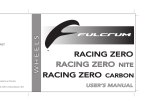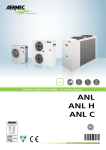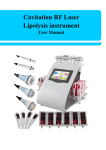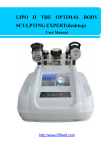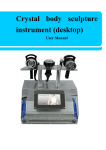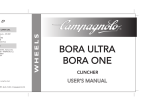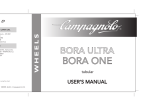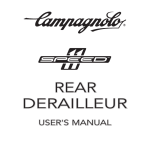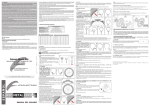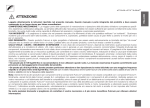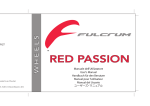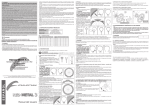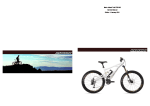Transcript
WARNING! Carefully read understand and follow the instructions provided in this manual. Failure to observe any instruction in this manual may damage the product and result in an accident, personal injury or death. This manual is an integral part of the wheels and must be kept in a safe place for future reference. MECHANIC QUALIFICATION - Please be advised that many bicycle service and repair tasks require specialized knowledge, tools and experience. General mechanical aptitude may not be sufficient to properly service or repair your bicycle. If you have any doubt whatsoever regarding your service/repair ability, please take your bicycle to a qualified repair shop. INTENDED USE - These Fulcrum® wheels have been designed and manufactured for use only on bicycles of the “cross-country” and “all mountain/enduro” types. Do not use them for downhill, freestyle, acrobatic, four-cross or any extreme off-road riding. Misuse of the wheel may result in an accident, personal injury or death. LIFESPAN - WEAR - INSPECTION REQUIREMENT - The lifespan of Fulcrum® wheels depends on many factors, such as rider size, tyres used and riding conditions. Impacts, falls, improper use or harsh use in general may compromise the structural integrity of the wheels and significantly reduce their lifespan. Some components of the wheels are also subject to wear over time. Please have your wheels regularly inspected by a qualified mechanic for any cracks, deformation, signs of fatigue or wear (use of penetrating fluid or other visual enhancers to locate cracks on parts is recommended). If the inspection reveals any deformation, cracks, impact marks or stress marks, no matter how slight, immediately replace the component; components that have experienced excessive wear also need immediate replacement. The frequency of inspection depends on many factors. Check with your authorized representative of Fulcrum Wheels S.r.l. to select a schedule that is best for you. Parts which have been bent or otherwise damaged in an accident or as a result of any other impact must not be re-straightened. They must be replaced immediately with original Fulcrum® parts. • If you weigh over 109 kg/240 lbs we advise you not to use this product. Non compliance with this warning can damage the product irreversibly. • If you weigh 82 kg/180 lbs or more, you must be especially vigilant and have your bicycle inspected more frequently (than someone weighing less than 82 kg/180 lbs). Check with your mechanic to discuss whether the wheels you selected are suitable for your use, and to determine the frequency of inspections. Note: Tools supplied by other manufacturers for wheels similar to Fulcrum® wheels may not be compatible with Fulcrum® wheels. Likewise, tools supplied by Fulcrum Wheels S.r.l. may not be compatible with components/wheels supplied by other manufacturers. Always check with your mechanic or the tool manufacturer to insure compatibility before using tools supplied by one manufacturer on components/wheels supplied by another. The user of these Fulcrum® wheels expressly recognizes that there are risks inherent in bicycle riding, including but not limited to the risk that a component of the bicycle can fail, resulting in an accident, personal injury or death. By his purchase and use of these Fulcrum® wheels, the user expressly, voluntarily and knowingly accepts and/or assumes these risks, including but not limited to the risk of passive or active neglicence of Fulcrum Wheels S.r.l. or hidden, latent or obvious defects in the product, and agrees to hold of Fulcrum Wheels S.r.l. harmless to the fullest extent permitted by law against any resulting damages. If you ever have any questions, please contact your mechanic or your nearest Fulcrum® dealer for additional information. Please note that throughout this manual, reference is made that an accident could occur. Please note that any accident can result in damage to your bicycle and, more importantly, personal injury or, death to you or a bystander. Always follow all warnings and instructions in this manual. Never make any modifications whatsoever to the Fulcrum® wheels or its components. WARNING! Always wear gloves and protective goggles when working on the wheels. PRE-RIDE INSPECTION WARNING! • Ensure that the quick release is adjusted correctly (see the “Quick Release” instruction leaflet). Bounce the bike on the ground from a height of about 10 cm/4” to ensure that there are no loose parts. An incorrectly adjusted quick release can lead to detachment of the wheel and reasult in an accident, personal injury or death. • Ensure that the wheels are centred perfectly. Turn the wheel to ensure that it does not wobble up and down or from one side to the other and that, if you are using rim brakes, it does not touch the brake pads. The use of wheels that are not centred properly or that have broken or damaged spokes can result in an accident, personal injury or death. • Carefully read the brake instructions provided by the brake manufacturer before use. • Check the correct operation of the brakes before starting to ride. • If you are using the bike on wet surfaces, remember that the adherence of the tyres on the ground can vary considerably and make it more difficult to control the bike. Also remember that because of the progressive drying of the braking surface while braking, the braking power can change sharply. Therefore take greater care when cycling in wet conditions to prevent possible accidents. • Always wear a properly fitted and fastened bicycle helmet that is approved in the country of use. • Learn and comply with the rules of the road and the cycling regulations in the place in which you use the bike. • Wear clothes that are close-fitting and make you easy to see (fluorescent or bright colours). Do not cycle at night as it is more difficult to be seen by others and to distinguish obstacles in your path. If you use the bike at night, use adequate lights and reflectors, fitted securely and clean. • If you have any other questions or comments, please contact your mechanic or nearest Fulcrum® dealer. DISC BRAKES VERSION Rim size FRONT 100mm - REAR 135mm FRONT DISC: 264,4 mm (RM1-DS11) - FRONT NO DISC: 269,4 mm (RM1-DS12) REAR LEFT: 264,4 mm (RM1-DS11) - REAR RIGHT: 269,4 mm (RM1-DS12) Inflation pressure see Table 1 - OPERATING PRESSURES TABLE 1 - Operating Pressures Printed on 100% recycled paper cod. 7225495 - 11/2010 - © Fulcrum Wheels 2010 Fulcrum Wheels S.r.l. reserves the right to modify the content of this manual without prior notice. The updated version will always be available on www.fulcrumwheels.com. On our website you will also find information on the other Fulcrum® products and the spare parts catalogue. ENGLISH 23 13 � � � Starting from the valve, pull the tyre until it comes out of the rim (Fig. 14). Continue around the whole wheel circumference. 15 • Unscrew the valve ring (A - Fig. 15) by hand and remove the valve. 17 16 18 5. PERIODICAL WHEEL MAINTENANCE Note We recommend that you contact a specialized mechanic for all the assembly, disassembly and all hub, rim and spoke replacement operations. Choose with him the most suitable interval of inspections for you on the basis of the conditions of use and intensity of your activities (e.g. racing, rain, salted roads, muddy roads, cyclist’s weight, etc.). � WARNING! 8,0 116 1,95 4,1 59 1,10 7,3 106 2,00 4,0 58 1,20 6,7 97 2,10 3,8 55 • Moisten the base of the rim with soap and water. 1,25 6,4 93 2,13 3,8 55 • Introduce a partially inflated presta inner tube into the tyre (Fig. 16). 1,38 5,8 84 2,20 3,6 52 1,50 5,3 77 2,25 3,6 52 • Fit the other bead of the tyre into the rim groove (Fig. 17) starting from the point opposite the valve, and continue around the whole circumference of the rim (Fig. 4), taking care not to pinch the tube. 1,60 5,0 73 2,30 3,5 51 1,75 4,6 67 2,35 3,4 49 1,85 4,3 62 2,40 3,3 48 1,90 4,2 61 All operations of the nipples should be performed using the special T-07 tool, included in this kit. Use of other tools could damage the nipples failure resulting in an accident, personal injury or death. • Inflate the inner tube until the two tyre beads go into place correctly (Fig. 18). WARNING! 2.5 - Removing the tyre WARNING! Whenever possible, install or remove tires by hand. If you are unable to do so, and must use a tool, use only the tire lever supplied with the wheel. Any other lever may damage the tire or rim, resulting in sudden an unexpected loss of tire pressure and an accident. 19 20 1 • Carry out the same operations on the other side of the tyre (Fig. 19 and 20). - Only use original Fulcrum M1-102 valves. • Lift off the tyre (Fig. 21). Note Completely remove one side of the tyre before going on to the other side. � - Tighten the valve ring (A – Fig. 1) by hand only. 2.6 - Checking the tightness of the UST Tubeless system (UST Tubeless rim + UST Tubeless tyre) 2.2 - Fitting the UST Tubeless tyre • Check that the tyre and rim are in good condition. WARNING! Whenever possible, install or remove tires by hand. If you are unable to do so, and must use a tool, use only the tire lever supplied with the wheel. Any other lever may damage the tire or rim, resulting in sudden an unexpected loss of tire pressure and an accident. • Check that the inside of the tyre and rim are perfectly clean; clean them with a cloth if necessary. • Put the tyre back after moistening the base of the rim with soap and water. 2 3 4 • Check that the tyre is coupled perfectly by inflating it to a pressure slightly above the recommended value (see Table 1 – Operating Pressures) and then deflating it completely: the tyre beads must remain coupled with the rim and not drop down into the rim groove. • Inflate the tyre to a pressure of 3 bar, immerse the wheel with its tyre in a basin of water or use a leakage detector spray to check for cuts or punctures. Replace the tyre if necessary. • If the leakage is in the valve zone, remove the valve, apply grease on the rubber part of the valve in contact with the rim and replace the valve. If leakage continues, change the valve. • Moisten the base of the rim with soap and water. • Fit the first bead of the tyre into the rim groove (Fig. 2) starting from the point opposite the valve. • Fit the other bead of the tyre into the rim groove (Fig. 3) starting from the point opposite the valve, and continue around the whole circumference of the rim (Fig. 4). 5 If after all these checks the tightness of the UST Tubeless system is still not satisfactory, contact your nearest Fulcrum® dealer. 3. ASSEMBLY AND DISASSEMBLY OF HG 8/9s OF SHIMANO INC. and PG 8/9s OF SRAM CORP. SPROCKETS 3.1 - Assembly • Fit the sprockets onto the freewheel body. • Using tool TL-LR15 from Shimano Inc. or FR-5 from Park Tool Co. (B - Fig. 22) tighten the ring (C - Fig. 22), provided with the sprockets, on the freewheel body 6 • Remove the ring (C - Fig. 22) using tool TL-LR15 from Shimano Inc. or FR-5 from Park Tool Co. (B - Fig. 22) and a chain whip (D - Fig. 22). • Remove the valve cap (B - Fig. 7). • Remove the sprockets from the freewheel body. • Unscrew the valve ring (C - Fig. 7). • Inflate the tyre until the two tyre beads go into place correctly (Fig. 8); you may hear a series of noises as the tyre settles while inflating. B CLOSE OPEN 4. BRAKES • Check that the distance between the tyre centring line and the margin of the tyre is constant around the whole circumference of the wheel. Fulcrum® Red Metal™ 1 XL wheels are available in the following versions: - for disc brakes with the ISO 6-bolts system; - for disc brakes "Center Lock" (with Fulcrum® Axial Fixing System™ - not compatible with "Center Lock" Oversize) 9 • Inflate until you achieve the desired inflation pressure. Never exceed the maximum pressure recommended by the tyre manufacturer and the maximum for the rim indicated in table 1 – Operating pressure. • Put back the valve cap (B - Fig. 9). C 3.2 - Disassembly 2.3 - Inflating the UST Tubeless tyre • Ensure that the tyre is positioned correctly by deflating it completely and checking that the tyre beads stay coupled in place 7 8 (Fig. 8) and do not drop towards the rim groove. D 22 to the tightening torque indicated from the ring manufacturer. • Ensure that the tyre is positioned correctly by moving it delicately ahead and behind on the rim (Fig. 6). • Screw back the valve ring (C - Fig. 9) When you transport the wheel separately from the bike or if you do not intend to use the wheel for a while, put it in a wheel bag to protect it from impacts, dust and dirt. • Deflate the tyre (Fig. 10). - Periodically check the tightness of the valve and of the entire UST Tubeless system (see paragraph 2.6). We recommend changing the Tubeless valve once a year to optimize tightness. WARNING! Choose the appropriate version for the type of brakes used. Do not use traditional brakes on a wheel for disc brakes and vice versa. Improper matching could result in an accident, personal injury or death. � � � � Only use non-aggressive products such as water and neutral soap or specific products designed for cleaning bicycles when cleaning the wheels. Do not use detergents or chemical cleaners. Dry them using a soft cloth. Never use abrasive or metal pads. 5.2 - TRANSPORT AND SAFEKEEPING • Starting from the valve, pull the tyre until it comes out of the rim (Fig. 14). Continue around the whole wheel circumference. ® ATTENTION! NOTE FOR SPECIALIZED MECHANICS CONTACT YOUR FULCRUM® SALES PARTNER OR YOUR FULCRUM SERVICE CENTER FOR THE INSTRUCTIONS FOR ASSEMBLING, MAINTAINING AND REPLACING RIMS, SPOKES AND HUBS. NOTES - Salt, mud and sand seriously damage bicycles and their components. Thoroughly rinse, clean and dry your bike after using it in these conditions. - If you use water under pressure to wash your bike, we recommend that you never point the water jet directly onto the hubs. Water under pressure, even just from the nozzle of a garden hose, can penetrate the seals inside hubs and irreparably damage the bearings. 21 • Starting from the point opposite the valve, press one side of the tyre with your hands until you uncouple the bead from its seat (Fig. 11), making it drop into the rim groove (Fig. 12). Continue around the whole wheel circumference (Fig. 13). 2.1 - Fitting the M1-102 Tubeless valve (Fig. 1) T-07 5.1 - CLEANING THE WHEELS Also when using an inner tube, proper coupling is absolutely necessary for preventing the tyre from coming off resulting in an accident, personal injury or death. WARNING! 5/7Nm ������� 44/62 in.lbs ������ 35 Nm - 310 in.lbs 1,00 Carefully follow the instructions provided by the UST tubeless tyre manufacturer. � • Deflate the tyre (Fig. 10). Max. Pressure [psi] - The valve is supplied already fitted on the rim. 24 14 Max. Pressure [bar] • Check that the tyre is positioned correctly on both sides of the valve zone (Fig. 5). USER'S MANUAL • Screw in the 6 screws to 5/7 Nm (44 / 62 in.lbs) (Fig. 24). Dimension [in] Note To prevent damaging the tyre it is necessary to complete the insertion of its bead exactly in correspondence with the valve. RED METAL 1 XL - the inner tube must be fitted with a valve of the Presta type (Ø 6,5 mm) Max. Pressure [psi] Never use a standard tyre on a UST Tubeless rim. To recognize a UST Tubeless tyre, check that it is marked with the UST Tubeless logo. www.fulcrumwheels.com • Fit the rotor into its seat, taking care with the direction of rotation indicated by the arrow (Fig. 24) Max. Pressure [bar] WARNING! TECH-INFO: [email protected] 4.2 - Assembling the rotor on the ISO 6-bolts system 12 Dimension [in] Notes • Tighten the lockring to 35 Nm (310 in.lbs) using the tool UT-BB130 (C - Fig. 23 - not provided) and torque wrench (D - Fig. 23). Notes - the use of rim tape is not required. • 26 UST Tubeless O.L.D. • Fit the washer (A - Fig. 23) and screw the provided lockring, code M1-101 (B – Fig. 23). • Starting from the point opposite the valve, press one side of the tyre with your hands until you uncouple the bead from its seat (Fig. 11), making it drop into the rim groove (Fig. 12). Continue around the whole wheel circumference (Fig. 13). 1. TECHNICAL SPECIFICATIONS Spokes lenght 11 10 Never enlarge the valve hole or redrill the rim. The rim would be irreparably damaged and would no longer permit the use of the Tubeless valve that is indispensable for the tightness of the UST Tubeless system. • Always use a spoke protection disc on the rear wheel. Check periodically that it is positioned correctly. The wheel you have purchased has been designed for use with UST Tubeless tyres. fax +39-0444-280749 2.4.1 - How to insert an inner tube WARNING! • Ensure that there are no damaged or loose spokes. tel. +39-0444-289306 • Fit the rotor into its seat, taking care with the direction of rotation indicated by the arrow (Fig. 23). • Always use original Fulcrum® spare parts. 2. TYRES Via Enrico Fermi 13 - 36057 Arcugnano (VI) - ITALY When you puncture the tyre, the air leakage is slow and not immediate and in some cases allows you to keep on pedalling back home. Remember that a UST Tubeless tyre can be repaired by applying a puncture repair patch or spray or by fitting a traditional inner tube. • Carefully follow the periodical maintenance program (See Chapter 5). • The rim wears with use and is subject to metal fatigue phenomena. Check the condition of the rim regularly, especially the braking track, and replace the rim when necessary. A worn rim or one showing signs of fatigue can break suddenly resulting in an accident, personal injury or death. Fulcrum Wheels S.r.l. 4.1 - Assembling the rotor on Axial Fixing System™ systems WARNING NEVER use pierce-resistant sealers containing alkaline substances (ammonia - sodium hydroxide). • Ensure that the brake cables and components are in good condition. • Ensure that the tyres are in good condition and check the inflating pressure before every ride. • Rim/tyre compatibility – If fitting the tyre onto a Fulcrum® rim is too easy, the tyre might be too big. Use only high-quality tyres whose fitting requires reasonable force. A tyre that is too big could result in unexpected loss of tyre pressure, an accident, personal injury or death. 2.4 - Punctures Note For use and maintenance instructions of the brakes, refer to the Instruction Leaflet provided by the brake manufacturer.
